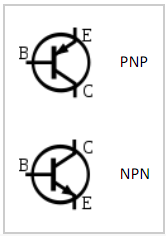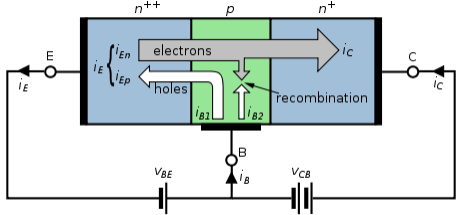Introduction
The bipolar junction transistor (BJT) is a three-terminal electronic device constructed from the doped semiconductor material and can be used in amplifying or switching applications. The Bipolar transistors are so named because their operation involves electrons and holes both. Charge flow in the BJT is because of bidirectional diffusion of charge carriers across the junction between 2 regions of different charge concentrations. This mode of operation is contrasted with the unipolar transistors, like field-effect transistors, in which only one carrier type is involved in the charge flow because of drift. By design, majority of the BJT collector current is because of the flow of charges injected from the high-concentration emitter into base where they are minority carriers which diffuse toward the collector, and thus BJTs are classified as the minority-carrier devices.

Schematic symbols for PNP- and NPN-type BJTs.

NPN BJT with forward-biased E-B junction and reverse-biased B-C junction
The NPN transistor can be considered as 2 diodes with a shared anode. In characteristic operation, the base-emitter junction is forward biased and base-collector junction is reverse biased. In the NPN transistor, for instance, when a positive voltage is applied to base-emitter junction, the equilibrium in between thermally generated carriers and repelling electric field of the depletion region becomes unbalanced, allowing thermally excited electrons to inject into base region. These electrons wander through the base from region of the high concentration near the emitter towards region of the low concentration near the collector. The electrons in the base are called as minority carriers because base is doped P type which would make holes the majority carrier in base.
To minimize percentage of carriers which recombine before reaching collector-base junction, the transistor's base region should be thin enough that carriers can diffuse across it in less time than the semiconductor's minority carrier lifetime. Specifically, the thickness of base should be less than the diffusion length of electrons. The collector-base junction is reverse-biased, and so little electron injection occurs from collector to the base, but the electrons which diffuse through the base towards collector are swept into collector by electric field in depletion region of collector base junction. The thin shared base and asymmetric collector-emitter doping is what differentiates the bipolar transistor from 2 separate and oppositely biased diodes connected in the series.
Email based Electronics Devices and circuits assignment help - homework help at Expertsmind
Are you searching Electronics Engineering assignment help expert for help with Bipolar Junction Transistor questions? Bipolar Junction Transistor topic is not easier to learn without any external help? We at www.expertsmind.com offers free lecture notes for Electronics Devices and circuits assignment help and Electronics Devices and circuits homework help. Live tutors are available 24x7 hours for helping students in their Bipolar Junction Transistor related problems. We provide step by step Bipolar Junction Transistor question's answers with 100% plagiarism free content. We prepare quality content and notes for Bipolar Junction Transistor topic under Electronics Devices and circuits theory and study material. These are avail for subscribed users and they can get advantages anytime.
Why Expertsmind for assignment help
- Higher degree holder and experienced experts network
- Punctuality and responsibility of work
- Quality solution with 100% plagiarism free answers
- Time on Delivery
- Privacy of information and details
- Excellence in solving electronics engineering questions in excels and word format.
- Best tutoring assistance 24x7 hours